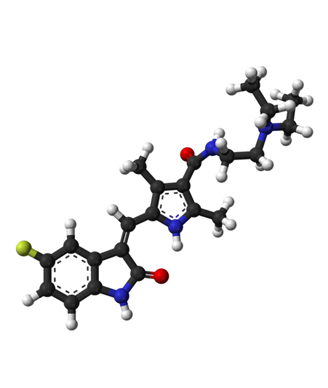ASCO: Sunitinib Improves PFS in Small-Cell Lung Cancer
A randomized, phase II trial showed improved progression-free survival in small-cell lung cancer with maintenance sunitinib vs placebo following standard chemotherapy, according to results presented at the ASCO annual meeting in Chicago.
Ball-and-stick model of sunitinib

A randomized, phase II trial showed improved progression-free survival in small-cell lung cancer with maintenance sunitinib vs placebo following standard chemotherapy, according to results presented at the annual meeting of the American Society of Clinical Oncology (ASCO) in Chicago.
Neal Ready, MD, PhD, of Duke University Medical Center in Durham, North Carolina, presented results of the ALLIANCE trial (CALBG 30504). The study tested a lower dose of the oral multi-targeted tyrosine kinase inhibitor sunitinib than in previous trials, where toxicity proved too much of a problem. The trial began as a study of concurrent chemotherapy and sunitinib, but was amended into a maintenance therapy trial when the combination was not well tolerated.
The study included 44 patients in the sunitinib group and 41 patients in the placebo group; all received a chemotherapy regimen of cisplatin or carboplatin and etoposide after enrollment but prior to randomization. The sunitinib was administered as a 150 mg loading dose on day 1 and then at 37.5 mg daily until disease progression. Crossover was allowed at progression, and 40% of patients did eventually cross over and receive sunitinib.
The primary endpoint, progression-free survival, was significantly better with sunitinib, at 3.77 months vs 2.30 months for a hazard ratio (HR) of 1.53 (90% CI, 1.03–2.27; P = .037). Overall survival showed a trend toward improvement with sunitinib, but did not reach significance, at 8.95 months vs. 6.89 months (HR = 1.17; 90% CI, 0.77–1.78; P = 0.27). Dr. Ready said the trial was not powered to show overall survival differences, and thus the slight improvement with the study drug should be interpreted with caution.
More patients in the sunitinib group received 5 to 8 cycles of maintenance therapy (22.7% vs 14.8%) and 9 or more cycles (9.1% vs 4.9%). There were more grade 3 and 4 toxicities with sunitinib, with fatigue and thrombocytopenia among the most common; the overall rate of grade 3/4 toxicity was 46.5% with sunitinib vs 19.5% for placebo. There were two grade 4 events in the study drug group (one gastrointestinal hemorrhage, one pancreatitis) and one in the placebo group (thrombocytopenia).
Dr. Ready said the crossover at progression could have influenced the survival data; in fact, an analysis of six patients who crossed over to sunitinib showed that tumors that had been growing either slowed their growth or shrank following crossover. He concluded that the improvement in progression-free survival and potential for overall survival benefit should lead to a phase III trial of this therapy option in small-cell lung cancer.
Heather Wakelee, MD, of Stanford University Medical Center in California, was the discussant for the session and pointed out that the toxicities still seem difficult to manage with this drug. “Grade 3 fatigue at 19% in the maintenance setting is a difficult thing to ask in our patients,” she said.
Dr. Wakelee also noted that previous work with drugs like bevacizumab and topotecan have shown similar promise to what this trial suggests with sunitinib, and little came of it. She urged caution in designing a phase III trial. “We clearly need improved treatments for our small-cell patients, I’m just not convinced that this is it.”